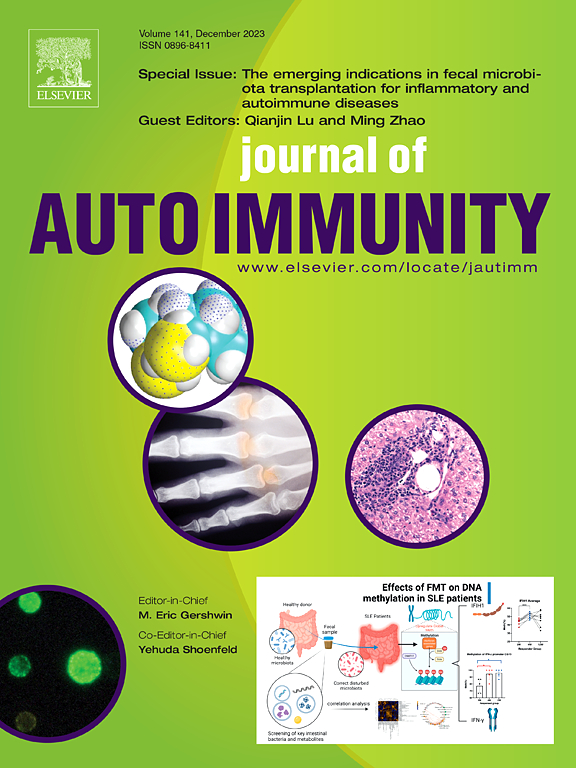Autoantibodies against a subunit of mitochondrial respiratory chain complex I in inclusion body myositis
IF 7.9
1区 医学
Q1 IMMUNOLOGY
引用次数: 0
Abstract
Background
Autoantibodies are found in up to 80 % of patients with idiopathic inflammatory myopathies (IIM) and are associated with distinct clinical phenotypes. Autoantibodies targeting cytosolic 5′-nucleotidase 1A (anti-NT5C1A) are currently the only known serum biomarker for the subgroup inclusion body myositis (IBM), although detected even in other autoimmune diseases. The aim of the study was to identify new autoimmune targets in IIM.
Methods
In a first cross-sectional exploratory study, samples from 219 IIM (108 Polymyositis (PM), 80 Dermatomyositis (DM) and 31 IBM) patients, 349 Systemic Lupus Erythematosus (SLE) patients and 306 population controls were screened for IgG reactivity against a panel of 357 proteins using an antigen bead array. All samples were identified in the local biobank of the Rheumatology clinic, Karolinska University Hospital. Positive hits for the IBM subgroup were then validated in an independent larger cohort of 287 patients with IBM followed at nine European rheumatological or neurological centers. IBM serum samples were explored by antigen bead array and results validated by Western blot. As controls, sera from 29 patients with PM and 30 with DM, HLA-matched with the Swedish IBM cohort, were included. Demographics, laboratory, clinical, and muscle biopsy data of the IBM cohort was retrieved.
Results
In the exploratory study, IgG reactivity towards NADH dehydrogenase 1 α subcomplex 11 (NDUFA11), a subunit of the membrane-bound mitochondrial respiratory chain complex I, was discovered with higher frequency in the IBM (9.7 %) than PM (2.8 %) and DM samples (1.3 %), although the difference was not statistically significant. Anti-NDUFA11 IgG was also found in 1.4 % of SLE and 2.0 % of population control samples. In the validation study, anti-NDUFA11 autoantibodies were detected in 10/287 IBM patients (3.5 %), 0/29 p.m. and 0/30 DM patients. Reactivity against NDUFA11 could be confirmed by Western blot. No statistically significant differences were found between patients with and without anti-NDUFA11 antibodies when comparing clinical, laboratory and histological data. However, we observed a trend of higher frequency of distal lower extremity muscle weakness, ragged red fibers and higher CK levels at time of diagnosis in the anti-NDUFA11 positive group. Co-existence of anti-NDUFA11 and anti-NT5C1A antibodies was not observed in any IBM patient.
Conclusion
Our results reveal a new autoimmune target in the mitochondrial respiratory chain complex I that might be specifically associated with IBM. This is of particular interest as mitochondrial abnormalities are known histological findings in muscle biopsies of IBM patients.
包涵体肌炎中针对线粒体呼吸链复合物 I 亚基的自身抗体。
背景:多达80%的特发性炎症性肌病(IIM)患者体内存在自身抗体,而且这些抗体与不同的临床表型有关。针对细胞膜5'-核苷酸酶1A(抗NT5C1A)的自身抗体是目前唯一已知的包涵体肌炎(IBM)亚组的血清生物标志物,尽管在其他自身免疫性疾病中也能检测到。本研究旨在确定包涵体肌炎的新自身免疫靶标:在首次横断面探索性研究中,使用抗原珠阵列对 219 名 IIM(108 名多发性肌炎 (PM)、80 名皮肌炎 (DM) 和 31 名 IBM)患者、349 名系统性红斑狼疮 (SLE) 患者和 306 名人群对照的样本进行了筛查,以检测针对 357 种蛋白质的 IgG 反应性。所有样本都在卡罗林斯卡大学医院风湿病诊所的本地生物库中进行了鉴定。随后,在九个欧洲风湿病学或神经学中心随访的 287 名 IBM 患者组成的独立大型队列中对 IBM 亚组的阳性结果进行了验证。通过抗原珠阵列检测了 IBM 血清样本,并通过 Western 印迹验证了结果。作为对照组,29 名 PM 患者和 30 名 DM 患者的血清与瑞典 IBM 患者的 HLA 相匹配。研究人员还检索了 IBM 队列的人口统计学、实验室、临床和肌肉活检数据:在探索性研究中发现,IBM样本(9.7%)对NADH脱氢酶1 α亚复合物11(NDUFA11)(一种膜结合线粒体呼吸链复合物I的亚基)的IgG反应频率高于PM样本(2.8%)和DM样本(1.3%),但差异无统计学意义。在 1.4% 的系统性红斑狼疮样本和 2.0% 的人群对照样本中也发现了抗 NDUFA11 IgG。在验证研究中,有10/287名IBM患者(3.5%)、0/29名p.m.患者和0/30名DM患者检测到抗NDUFA11自身抗体。对 NDUFA11 的反应性可通过 Western 印迹得到证实。在比较临床、实验室和组织学数据时,未发现有抗NDUFA11抗体和无抗NDUFA11抗体的患者之间存在明显的统计学差异。不过,我们观察到抗-NDUFA11抗体阳性组患者在确诊时出现下肢远端肌无力、红色纤维褴褛和CK水平升高的频率较高。在所有 IBM 患者中均未观察到抗 NDUFA11 和抗 NT5C1A 抗体同时存在:我们的研究结果揭示了线粒体呼吸链复合物 I 中的一个新的自身免疫靶点,该靶点可能与 IBM 特别相关。结论:我们的研究结果揭示了线粒体呼吸链复合物 I 中新的自身免疫靶点,它可能与 IBM 特别相关,因为线粒体异常是 IBM 患者肌肉活检的已知组织学发现。
本文章由计算机程序翻译,如有差异,请以英文原文为准。
求助全文
约1分钟内获得全文
求助全文
来源期刊

Journal of autoimmunity
医学-免疫学
CiteScore
27.90
自引率
1.60%
发文量
117
审稿时长
17 days
期刊介绍:
The Journal of Autoimmunity serves as the primary publication for research on various facets of autoimmunity. These include topics such as the mechanism of self-recognition, regulation of autoimmune responses, experimental autoimmune diseases, diagnostic tests for autoantibodies, as well as the epidemiology, pathophysiology, and treatment of autoimmune diseases. While the journal covers a wide range of subjects, it emphasizes papers exploring the genetic, molecular biology, and cellular aspects of the field.
The Journal of Translational Autoimmunity, on the other hand, is a subsidiary journal of the Journal of Autoimmunity. It focuses specifically on translating scientific discoveries in autoimmunity into clinical applications and practical solutions. By highlighting research that bridges the gap between basic science and clinical practice, the Journal of Translational Autoimmunity aims to advance the understanding and treatment of autoimmune diseases.
 求助内容:
求助内容: 应助结果提醒方式:
应助结果提醒方式:


